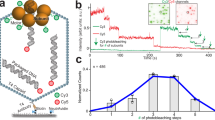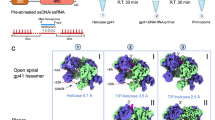Abstract.
Genome packaging into an empty capsid is an essential step in the assembly of many complex viruses. In double-stranded RNA (dsRNA) bacteriophages of the Cystoviridae family this step is performed by a hexameric helicase P4 which is one of the simplest packaging motors found in nature. Biochemical and structural studies of P4 proteins have led to a surprising finding that these proteins bear mechanistic and structural similarities to a variety of the pervasive RecA/F1-ATPase-like motors that are involved in diverse biological functions. This review describes the role of P4 proteins in assembly, transcription and replication of dsRNA bacteriophages as it has emerged over the past decade while focusing on the most recent structural studies. The P4 mechanism is compared with the models proposed for the related hexameric motors.
Similar content being viewed by others
Author information
Authors and Affiliations
Corresponding author
Additional information
Received 30 September 2005; received after revision 8 December 2005; accepted 27 December 2005
Rights and permissions
About this article
Cite this article
Kainov, D.E., Tuma, R. & Mancini, E.J. Hexameric molecular motors: P4 packaging ATPase unravels the mechanism. Cell. Mol. Life Sci. 63, 1095–1105 (2006). https://doi.org/10.1007/s00018-005-5450-3
Published:
Issue Date:
DOI: https://doi.org/10.1007/s00018-005-5450-3




